

Why aren’t there more CVTs?Įventually, all cars might have CVTs, but currently there’s some customer resistance (as there often is with new technology). Looked after properly, a CVT will last as long as any other transmission. The belt, a weakness in the past, is now made of steel and composites. There’s no question of the auto box hunting for the right gear, so the ride is usually very smooth. Fuel consumption and emissions are both reduced. Instead, a belt runs on cone-shaped pulleys (some manufacturers use chains), thus providing “continuous variation.” A CVT always delivers exactly the power demanded of it, so the engine runs at peak efficiency. Why? There are two main reasons: ease (and therefore cost) of manufacture and the efficient way a CVT delivers power.Ī CVT has no gears (though a few models include a first, or “launch,” gear). Why choose a CVT?īy our estimation, there are over 200 cars and light trucks using CVT today, and industry sources suggest that the number is likely to increase. Despite a minor resurgence in the late 1950s (when Dutch truck maker DAF produced a range of small 500 cc and 600 cc cars), it wasn’t until the early 2000s that CVTs started to reappear in greater numbers. At first, when production methods weren’t what they are today, the belt was the weak point. Though it’s easier to make than a traditional geared transmission, CVT uses a belt drive. It was first used in a sawmill engine in the 1870s, and it appeared in cars soon after. The continuously variable transmission is not a new idea. In 1490, Leonardo Da Vinci had the first recorded idea for a continuously variable transmission.


 0 kommentar(er)
0 kommentar(er)
